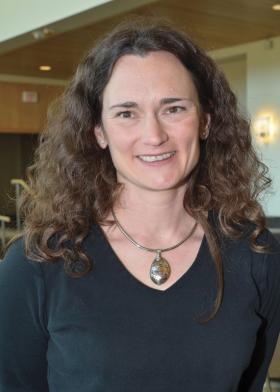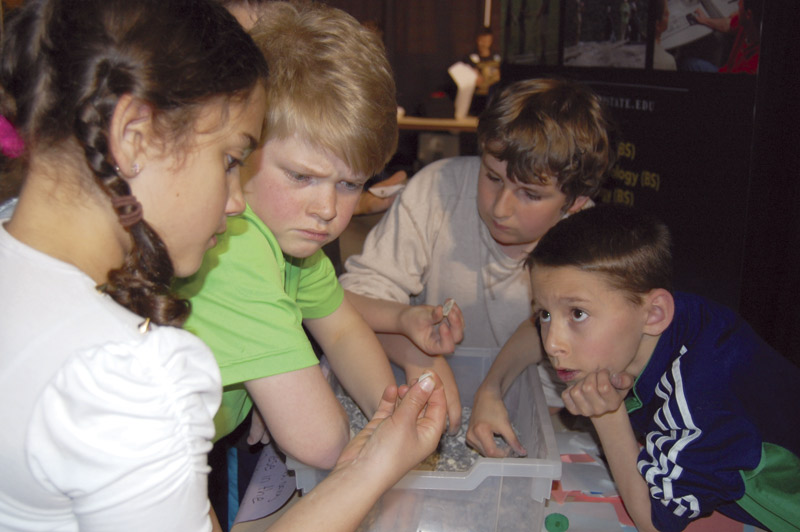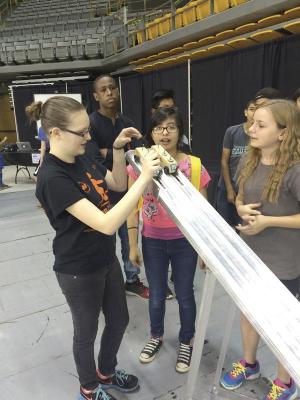An Outreach Adventure
Fall
2016
Pathways - Advice from Experienced Voices
An Outreach Adventure
A successful event that didn’t go as planned
By:Tonya Coffey
 I have always loved science outreach, especially when it is with younger children. Their enthusiasm is so exciting to see; it helps me remember why I started studying physics in the first place. But my most successful outreach project didnít go at all like I'd planned.
I have always loved science outreach, especially when it is with younger children. Their enthusiasm is so exciting to see; it helps me remember why I started studying physics in the first place. But my most successful outreach project didnít go at all like I'd planned.
In the early months of 2010, I was recruited to host events for the North Carolina Science Festival, the first statewide science festival. The organizers wanted Appalachian State University (ASU), where I am a physics professor, to host events so western North Carolina could participate. I met with several faculty on campus who regularly host STEM outreach events. We agreed to host multiple events, including talks, a stargazing event at our Dark Sky Observatory, and a multidisciplinary STEM open house that we called the ASU Science Expo. I agreed to coordinate the Expo.
Our first Expo was not a success. Despite plenty of advertising and cool STEM booths, we only had about 50 attendees over a three-hour period on a Sunday afternoon. I was disappointed. I decided that the following year we would have the Expo on a school day and invite local teachers to bring their 6th–12th grade students on field trips. That way, we’d have a captive audience.

For the next festival, I envisioned teachers bringing their science class of 20 or 30 students. I was aiming for about 200–250 students over four hours. I planned to stagger attendees through the floor by offering activities, tours, and shows around campus. Some of our special events included tours and demos of our advanced microscopes, sungazing at our observatory, a laser show, and hands-on projects.
I sent the first e-mail to the teachers at about 11 a.m. on January 23, 2012. By 5 p.m. of that same day, 350 students were registered for the Expo. I was pleased but surprised, because those 350 students were coming from only two or three schools. When they registered, the teachers signed up all the sixth graders in their school to attend, not just their class. “How wonderful that you’re doing this! I’ve been waiting for Appalachian to do something like this for a long time,” one teacher e-mailed. By the end of the second day of registration, 500 students were coming to the Expo. By the end of the first week, it was up to 700. I needed more space, presenters, and money. I needed more everything.
I sent an e-mail to the dean of the College of Arts and Sciences. It started: “Help. This Science Expo is getting out of control…” The e-mail I sent to the chancellor, provost, and my dean on February 9 was more formal, but the panic is still visible: “…I now have 1,100 middle and high school students coming on April 16, and I am turning away all further requests for attendance.…I could use some support with the event's organization.”
 Within one week I had a new best friend, Tracey Tardiff, from our College Awareness Program. Tracey regularly arranges tours and coordinates large events for the university. We booked Holmes Convocation Center for the Expo floor and hosted the special events around campus. In an event of this size, there are a myriad of tiny details—we had to see to them all.
Within one week I had a new best friend, Tracey Tardiff, from our College Awareness Program. Tracey regularly arranges tours and coordinates large events for the university. We booked Holmes Convocation Center for the Expo floor and hosted the special events around campus. In an event of this size, there are a myriad of tiny details—we had to see to them all.
In the end, we were a big hit! Teachers were already trying to book a spot at the next Expo. It’s become normal for us to receive requests over six months in advance. Tracey and I now work with a committee of organizers. I write at least two small grant proposals each year to fund the Expo, and attendance is now capped at roughly 2,500 students. We have around 40 booths and more than a dozen special events from more than 20 different academic departments, with roughly 150 volunteers from our faculty, staff, and students. Following national trends in education, we’ve gone from a STEM Expo to a STEAM Expo (the A stands for arts). Through it all, though, the heart of the event has remained the same: to excite students about learning science.
Getting involved—Some tips
If my story didn’t scare you too much and you’re still interested in outreach, ask around and get involved.
- Most colleges and universities have existing outreach programs that could really use your help.
- If there’s no existing outreach program, just contact the principal of a local public school. They love to have visiting scientists work with their students.
- If you have to design your own content, know your audience. What you present to a 2nd grader is not the same as what you would present to a high school student.
- Demo shows are wonderful, and everyone loves them. But if you really want the audience to learn, hands-on activities or something more interactive is a superior approach.
- The best advice I can give is this: Know when to ask for help!
//
